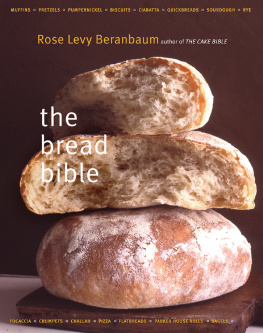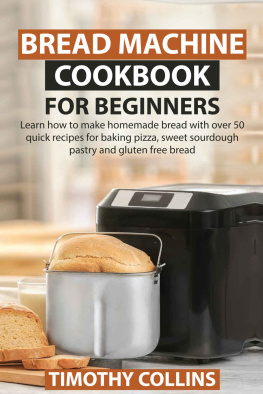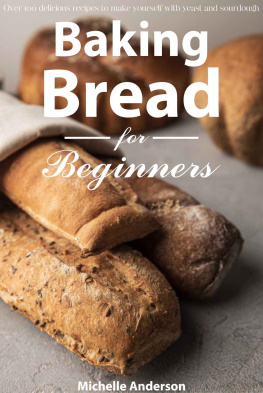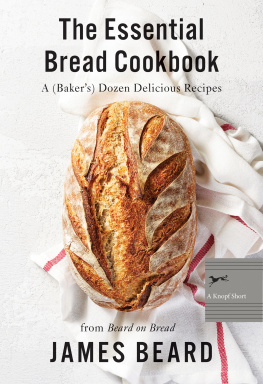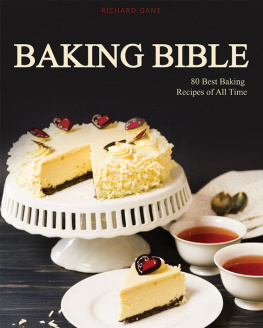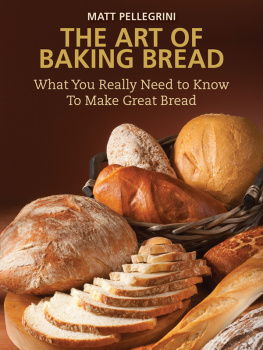Rose Levy Beranbaum
the
bread
bible
photographs by gentl & hyers / edge
illustrations by alan witschonke
foreword by michael batterberry
W. W. Norton & Company
New York London

Copyright 2003 by Rose Levy Beranbaum
Photographs copyright 2003 by Gentl and Hyers
Illustrations copyright 2003 by Alan Witschonke
KitchenAid and the mixer shape are registered trademarks of KitchenAid, USA, used by permission.
Bundt is a licensed registered trademark of Northland Aluminum Products Company.
The Publisher and the Author make grateful acknowledgment for permission to include the following:
Recipe for , adapted from focaccia recipe in Baking a Flatbread with an Inlay of Herbs, Fine Cooking, November 1998, by Maggie Glezer. Included by permission of Maggie Glezer.
Step-by-step adapted from Ben Finks photographs in Fine Cooking. Adapted by permission of Ben Fink.
This publication contains the opinions and ideas of its author and is designed to provide useful advice to the reader on the subject matter created. When using any of the equipment recommended in this book, always follow the manufacturers instructions or contact the manufacturer directly. Prior to using any recipe in this book, review it for any ingredient to which you may be allergic. The publisher and author specifically disclaim any reponsibility for any liability, loss, or risk (financial, personal, or otherwise) that may be claimed or incurred as a consequence, directly or indirectly, of the use and/or application of any of the contents of this publication.
All rights reserved
Printed in the United States of America
First Edition
For information about permission to reproduce selections from this book, write to Permissions, W. W. Norton & Company, Inc., 500 Fifth Avenue, New York, NY 10110
Manufacturing by The Maple-Vail Book Manufacturing Group
Book design by Jean Orlebeke
Production manager: Andrew Marasia
Library of Congress Cataloging-in-Publication Data
Beranbaum, Rose Levy.
The bread bible / by Rose Levy Beranbaum ; photographs by Gentl & Hyers/Edge ; illustrations by Alan Witschonke ; foreword by Michael Batterberry.
p. cm.
Includes bibliographical references and index.
ISBN 0-393-05794-1
1. Bread. I. Title.
TX769.B365 2003
641.8'15dc21
2003044550
W. W. Norton & Company, Inc., 500 Fifth Avenue, New York, N.Y. 10110
www.wwnorton.com
W. W. Norton & Company Ltd., Castle House, 75/76 Wells Street, London W1T 3QT
1 2 3 4 5 6 7 8 9 0
To my paratrooper father, Robert Maxwell Levy, who gave me
his wings, the courage to fly, and the freedom to dream.
For the generous bread bakers who shared their recipes with
me and bread bakers everywhere.
To the memory of Lionel Poilne, one of the greatest bread
bakers of all time.


Contents
> Before you follow a link, please bookmark your page.
> The Ingredients and Dough Percentage charts are treated as images. Please enlarge for greater readability.
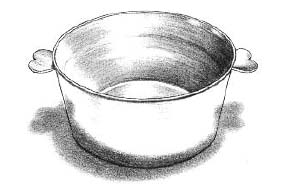
THIS IS MY BREAD BIOGRAPHY. IT IS A PERSONAL HISTORY OF BREAD FROM MY first memory of its appearance into my existencethe bagel my mother gave me as a teething ringto my most recent achievementa bread risen entirely from my own sourdough starter. Some of the recipes along this journey were created from my imagination. Others were inspired by breads tasted on my travels abroad. Still others are treasures shared by other bakers that I have made my own, as all bakers are wont to do. The experience of putting together this book and researching all the aspects of bread making has been one of the steepest and most gratifying learning curves of my life. And it has been a humbling experience as well, opening the way for a lifetime of continued discovery.
Occasionally people suggest that making bread, particularly kneading it, must be a great way to get out aggression. The irony is that when I start making bread, I am immediately blissed out and any possible aggression immediately evaporates. I dont need to pound the bread with my fists to arrive at this blessed state. In fact, when I dont have a bread going, I feel that something is missing. Could it be that Im only completely happy now when a bread is happening somewhere nearby?
There is a satisfaction derived from the act of baking bread that I get from no other kitchen activity. Perhaps the most engaging aspect is that yeast is a dormant live organism one is bringing to life and feeding so that it will grow and expand, providing texture and flavor in the bread. It always seems utterly amazing that flour, water, yeast, and salt, judiciously proportioned, transform into the most perfect loaf of bread.
Coincidentally, my serious interest in wine began about eight years ago, the same time I started working seriously on this bread book. It was at the Huia vineyard in South New Zealand, when the vintner was explaining to me why he had to cool down the fermenting wine to prevent undesirable flavors, that it hit me how incredibly similar the process of making bread is to that of making wine. Both rely on yeast fermentation, time, and temperature control to produce fantastic flavors in the end product. The wild yeast for wine is present on the grapes skin; for bread it is present on the wheat. But both usually rely on the addition of a commercial yeast starter or culture.
The sugar in the grape feeds the yeast that produces alcohol and carbon dioxide, the two end products of fermentation, just as the sugar in the flour feeds the yeast to the same end. And just as a specific variety of grape or blend of grapes produces a specific variety of wine, different varieties of flour produce different types of bread. Surely it is more than coincidence that the ancient tradition of Hebrew grace before the meal begins with the prayer of thanks for the wine and immediately follows with the prayer of thanks for the breadthe only two parts of the meal thus honored. Though I dont speak conversational Hebrew, these Hebrew prayers are ingrained in my soul. And I think of bread and wine as the foundation of my culinary existence.
My first experience of eating home-baked bread was not until I was seventeen and a freshman at the University of Vermont. A local resident paid my boyfriend with a loaf of her bread for mowing the lawn. It vaguely captured my attentionhe was so pleased about it. He made fried egg sandwiches for us for a hunting tripsomething I would normally have rejected on concept (both the fried egg and the hunting)but I was in love, it was so cold, and I was so hungry and it was an epiphany. My first school vacation back in New York I borrowed The Joy of Cooking from Rosalind Streeter, a neighbor and friend of my mothers, and made my first bread. It is a tribute to the perfect instructions that so was the bread.
But the seed of desire to bake bread actually had already been planted deeply within me by my craftsman father, whose dream it was to make a real hearth beehive oven. I remember the first time he mentioned it, and my reaction: Why? Now, all these years later, I share the dream. One of my favorite childhood stories was my fathers about his canoeing trip up the Hudson River. (I was a city kid, but with the benefit of a genuine backwoodsby choicefather.) A short while before the trip he had begun a sourdough starter, from a book called
Next page
